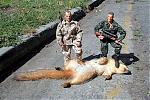-
Council Member

 USAF and USN Comments on IED's and CAS
USAF and USN Comments on IED's and CAS
UAVs, Other Aircraft Being Misused, ACC chief Says
Jun 21, 2007
Michael Fabey/Aerospace Daily & Defense Report
Using unmanned aerial vehicles (UAVs) and pod-equipped combat jets to find improvised explosive devices (IEDs) is often a misuse of time and resources, said U.S. Air Force Gen. Ronald Keys, commander of Air Combat Command.
Often, requests for airborne surveillance are based on the assumption that such aircraft help find IEDs and save ground forces from such attacks, he said. Certain military leaders feel they need the full-motion video feeds to locate the explosives. The truth, he said, is much different.
Based on Air Force analysis, the number of IEDs found by UAVs, surveillance aircraft or combat jets outfitted with advanced targeting pods per 100,000 flight hours is very low, according to Keys. "It's a waste," Keys said June 20 during a morning keynote speech at the Transformation Warfare 07 conference and exhibit in Virginia Beach, Va.
"People come to me and tell me they want a Predator," he said. "I ask, 'What are you looking for?' Tell me what you're looking for, don't just tell me you want a J-STARS."
Unfortunately, the military is basing some of its decisions on anecdotes instead of real metrics, he said. Indeed, the only metric being used is whether the Air Force is meeting certain tasking orders, instead of making sure those assets and flights are effective and the best use of time and aircraft. "This is no way to fight a war," he said.
Keys said ACC has developed a "concept of deployment" to help fight IEDs that is air-centric "to a certain point." Without going into specifics, he said, "We ought to be attacking the system - to the left of 'the bang,'" meaning the process before the IED is emplaced. What needs to be looked at is the network, "not the thing that's buried out there," he said.
Flying pod-outfitted F-16s up and down streets no one will be on for another 12 hours will not help the IED fight, he said. Looking for buried IEDs in Iraq in that fashion is not the best way to stop attacks. "It's a junkyard out there," he said, adding there are too many false positives.
and
More News from Recent Precision Strike Assn. Symposium Aviation Week & Space Technology 07/23/2007, page 11
Edited by Patricia Parmalee
Printed headline: More From Virginia Beach
U.S. Navy Capt. Scott Stearney, commander of Carrier Air Group Seven, which just returned from duty in the Middle East, says his recent deployment was the first in which nonkinetic effects were emphasized during operations. Kinetic and nonkinetic effects—such as electronic warfare—were “equally important” during recent ops, he said during the association’s symposium. On the kinetic side, use of the GBU-38, a 500-lb. GPS-guided bomb, was widespread but pilots are increasingly turning to strafing to kill targets in Iraq, he says. The Army’s systems, meanwhile, are becoming so precise and reliable that operators are using the Guided Multiple Launch Rocket System (GMLRS) in an air support role to help troops under fire. GMLRS is so reliable that during recent engagements 83% of them were fired in an urban environment—earlier rocket systems were typically not used in this role. And, 69% of the rockets fired were used to support troops under direct enemy fire.
Two very interesting points of view.
Last edited by Jedburgh; 08-03-2007 at 05:08 PM.
Reason: Added link.
 Posting Permissions
Posting Permissions
- You may not post new threads
- You may not post replies
- You may not post attachments
- You may not edit your posts
-
Forum Rules







Bookmarks